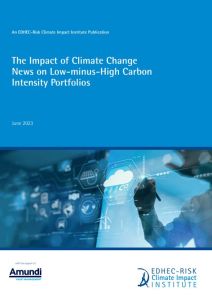

The Impact of Climate Change News on Low-minus-High Carbon Intensity Portfolios
Several pioneering papers have already examined the link between climate news and equity market returns with a view to isolating “climate beta” that could be used ...
Author(s):
Summary:
Several pioneering papers have already examined the link between climate news and equity market returns with a view to isolating “climate beta” that could be used to construct climate-risk hedging portfolios with easy-to-trade assets. However, this study applies the latest natural language processing methods to construct climate news indices from newspaper articles. Linguistic dictionary, lexical sentiment-based techniques, and state-of-the-art transformer-based models are used to capture climate change concerns in leading newspapers over the 2005-2021 period.
Daily indices are built for each source and for the aggregation of all five major news sources. The authors isolate the unexpected changes in these indices and study the relationship between these innovations and the daily changes in value of portfolios of large capitalisation companies listed in the United States.
Sorting by the carbon intensity of issuers, the authors then create a high carbon intensity portfolio from the top tercile, a low carbon intensity portfolio from the bottom tercile, and a long-short portfolio of low-minus-high carbon intensity stocks. Portfolio returns are regressed against each climate news innovation index (while controlling for exposure to standard return factors).
When single news sources are used to construct each index, the authors observe statistical significance (at the commonly used 5% level) for only a quarter of the indices for high carbon intensity portfolios and a sliver of the indices for long-short portfolios. However, when the aggregate index is used, statistical significance is observed for almost all the language models for the high carbon intensity portfolios and two thirds of these models for the long-short portfolios – aggregation reduces the weight of idiosyncratic articles.
These results are consistent with previous studies documenting overperformance of low over high carbon intensity portfolios in reaction to innovations in climate change concerns, but the authors find that this outperformance arises from the fall in the value of the high carbon intensity portfolios. Interestingly, the value added by the most advanced approaches relative to the simple attention-based model is modest.
The authors’ documentation of a negative reaction of high carbon intensity equity prices to climate change concerns (as reflected in the news) is consistent with the intuition that higher carbon intensity activities have higher exposure to the risks arising from climate change and climate change action. The finding that this relationship is statistically significant and of the right sign is good news; however, as in previous studies, the economic impact does not appear significant enough for comfort – one disquieting explanation for investors is that equity prices have yet to adjust to the climate emergency.
Register to download PDF
Register/Log in| Type : | EDHEC Publication |
|---|---|
| Date : | 11/09/2023 |

